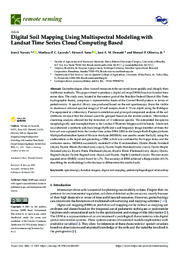Digital Soil Mapping Using Multispectral Modeling with Landsat Time Series Cloud Computing Based.
Digital Soil Mapping Using Multispectral Modeling with Landsat Time Series Cloud Computing Based.
Autoria: NOVAIS, J. J.; LACERDA, M. P. C.; SANO, E. E.; DEMATTÊ, J. A. M.; OLIVEIRA JÚNIOR, M. P.
Resumo: Abstract: Geotechnologies allow natural resources to be surveyed more quickly and cheaply than traditional methods. This paper aimed to produce a digital soil map (DSM) based on Landsat time series data. The study area, located in the eastern part of the Brazilian Federal District (Rio Preto hydrographic basin), comprises a representative basin of the Central Brazil plateau in terms of pedodiversity. A spectral library was produced based on the soil spectroscopy (from the visible to shortwave infrared spectral range) of 42 soil samples from 0?15 cm depth using the Fieldspec Pro equipment in a laboratory. Pearson?s correlation and principal component analysis of the soil attributes revealed that the dataset could be grouped based on the texture content. Hierarchical clustering analysis allowed for the extraction of 13 reference spectra. We interpreted the spectra morphologically and resampled them to the Landsat 5 Thematic Mapper satellite bands. Afterward, we elaborated a synthetic soil/rock image (SySI) and a soil frequency image (number of times the bare soil was captured) from the Landsat time series (1984?2020) in the Google Earth Engine platform. Multiple Endmember Spectral Mixture Analysis (MESMA) was used to model the SySI, using the endmembers as the input and generating a DSM, which was validated by the Kappa index and the confusion matrix. MESMA successfully modeled 9 of the 13 endmembers: Dystric Rhodic Ferralsol (clayic); Dystric Rhodic Ferralsol (very clayic); Dystric Haplic Ferralsol (loam-clayic); Dystric Haplic Ferralsol (clayic); Dystric Petric Plinthosol (clayic); Dystric Petric Plinthosol (very clayic); Dystric Regosol (clayic); Dystric Regosol (very clayic); and Dystric, Haplic Cambisol (clayic). The root mean squared error (RMSE) varied from 0 to 1.3%. The accuracy of DSM achieved a Kappa index of 0.74, describing the methodology?s effectiveness to differentiate the studied soils.
Ano de publicação: 2021
Tipo de publicação: Artigo de periódico
Unidade: Embrapa Cerrados
Palavras-chave: Espectroscopia, Mapeamento digital do solo, Spectroscopy
Observações
1 - Por padrão são exibidas publicações dos últimos 20 anos. Para encontrar publicações mais antigas, configure o filtro ano de publicação, colocando o ano a partir do qual você deseja encontrar publicações. O filtro está na coluna da esquerda na busca acima.
2 - Para ler algumas publicações da Embrapa (apenas as que estão em formato ePub), é necessário ter, no celular ou computador, um desses softwares gratuitos. Sistemas Android: Google Play Livros; IOS: iBooks; Windows e Linux: software Calibre.
Acesse outras publicações
Acesse a Base de Dados da Pesquisa Agropecuária (BDPA) para consultar o acervo completo das bibliotecas da Embrapa.

